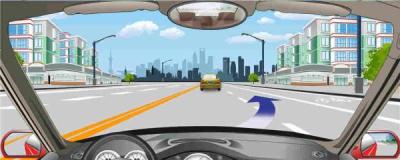1、The broken white line on the right side of the road indicates that drivers are allowed to change lanes by crossing the line.

A、Right
B、Wrong
Answer:A
2、Under such circumstances, what should motor vehicle drivers do?

A、Overtake the vehicle quickly on its left
B、Keep a long braking space
C、Continuously sound the horn to alert the vehicle in front
D、Overtake the vehicle quickly from its right
Answer:B
3、When extinguishing fire, the synthetic-made garments should not be taken off in order to protect the exposed skin from burning.
A、Right
B、Wrong
Answer:B
4、In order to keep safe when driving on the highway, which ones of the following statements are prohibited acts?
A、Reversing, moving against regulations, making a U-turn by crossing the central divider, or stopping in the lane.
B、Riding or rolling on the lane-dividing line or driving on the shoulder
C、Overtaking on ramps, accelerations lanes, ordeceleration lanes.
D、Testing vehicles or learning to drive a vehicle
Answer:ABCD
5、How should a motor vehicle follow the other vehicle In front when driving on a road covered with ice and snow?
A、Keep a long safe distance
B、Turn on hazard lamp
C、Change between high-and-low beam alternatively
D、Sound the horn in due time to give a notice to the vehicle in front
Answer:A
6、When encountering this situation in a residential area the driver should sound the horn continuously.

A、Right
B、Wrong
Answer:B
7、A driver should accelerate in advance to overtake then it is likely to meet with oncoming vehicles.
A、Right
B、Wrong
Answer:B
8、When driving on a long downhill road, which is the best way to control driving speed?
A、Coast in neutral gear
B、Depress the clutch and coast
C、Use the engine to brake
D、Depress the brake pedal continuously
Answer:C
9、When a wounded person suffering bone fracture in the thigh, shank or spine, moving the wounded person is usually prohibited.
A、Right
B、Wrong
Answer:A
10、Under such circumstances, motor vehicle drivers should reduce speed by the right side swiftly and yield.

A、Right
B、Wrong
Answer:A
11、When the fuel of a motor vehicle catches fire, which of the following things cannot be used to put out the fire?
A、Sandy soil on the roadside
B、Cotton-padded clothes
C、Overalls
D、Water
Answer:D
12、How many kinds of law-breaking acts are displayed in flash 3?

A、One
B、Two
C、Three
D、Four
Answer:B
13、When a bicycle occupies the motor vehicle lane and obstructs the traffic, the driver should sound the horncontinuously and speed up to bypass on the left of the bicycle.
A、Right
B、Wrong
Answer:B
14、When a wounded person suffering burns is thirsty he/she may drink a small quantity of lightly salty water.
A、Right
B、Wrong
Answer:A
15、When a motor vehicle encounters an emergency on an expressway, the driver should not swiftly turn the steering wheel to evade.
A、Right
B、Wrong
Answer:A
16、This sign warns to bypass from the left side to avoid the roadblock.

A、Right
B、Wrong
Answer:B
17、When a fast-moving vehicle is likely to collide with the vehicle in front, what should the driver do?
A、Brake to reduce speed first, and then steer to evade
B、Turn the steering wheel quickly to the left side to evade
C、Turn the steering wheel quickly to the right side to evade
D、Steer to evade first, and then brake to reduce speed
Answer:A
18、Under such circumstances, what should be done by a motor vehicle driver in order to yield out of courtesy?

A、Driving at a higher speed
B、Closely following the vehicle in front
C、Driving at a higher speed by the right side
D、Driving at a lower speed by the right side
Answer:D
19、Sounding the horn on a foggy daY can arouse the attention of the opposite side. After hearing the horn from the opposite side, the driver should also sound their own horn to respond.
A、Right
B、Wrong
Answer:A
20、The sign on the right warns of a widened right-hand road ahead.

A、Right
B、Wrong
Answer:B